
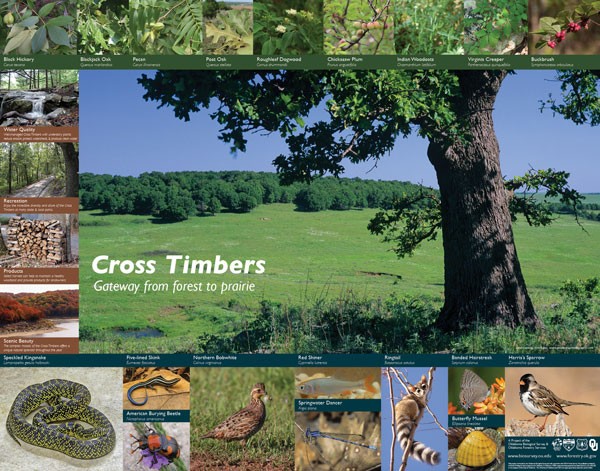
About
The woodlands of central Oklahoma are the transition from our eastern forests to the western prairies. These woodlands, known as the Cross Timbers, are a mosaic of thick forest, open woodland, and prairie patches. Of Oklahoma’s 12.7 million acres of forest land, about 4 million acres are in the Cross Timbers.
What Makes Up the Cross Timbers?
A complex mosaic of upland deciduous forest, savanna, and prairie, the Cross Timbers spreads across central Oklahoma north into Kansas and south into Texas. Post oak, blackjack oak, and black hickory dominate the Cross Timbers, with blackjack becoming more common in the west – making a healthy Cross Timbers stand look different in eastern Oklahoma as compared to central and western portions of the state. Beneath and between trees, a diversity of other plants flourish. Understory trees, such as roughleaf dogwood and redbud, bloom beneath the canopy. Low shrubby plants like buckbrush and fragrant sumac provide habitat and food for small wil dlife species. A variety of grasses and wildflowers that are typical of the prairie will thrive in the sunny gaps between trees. Indian grass, big bluestem, coneflowers, and Indian blanket shoot up where sunlight is abundant.
Because this forest type holds limited commercial va lue for timber production, it has not experienced large-scale industrial logging. Sizable tracts of old growth post oak and blackjack oak forests are still found in many parts of Oklahoma with trees as old as 400 years. In spite of their age, the trees average only 15 to 40 feet tall and 5 to 20 inches in diameter.
History
When Oklahoma Territory was opened for settlement, newcomers found much of the Cross Timbers to be impassable, thick forests. The strong scrubby oak trees with low branches blocked the easy passage through this forest. In 1832, the American writer Washington Irving traveled through the region, describing the Cross Timbers in his travelogue A Tour on the Prairies as “vexations of flesh and spirit” and as they moved across the area, it was as if “struggling through forests of cast iron.”
Conservation
What is Happening to the Cross Timbers?
The Cross Timbers woodlands have changed since Irving visited Oklahoma Territory. Cross Timbers forests developed over many centuries and are sensitive to change, especially such large-scale modifications as road construction and urban development. Fragmentation of the Cross Timbers occurs when we convert forest to agriculture lands, build new housing, and develop oil and gas resources, all of which impact wildlife habitat as well as watershed health.
Also, the Cross Timbers is being taken over by invasive species. Exotic species from Asia and Europe are displacing our native plants and changing the nature of our forests. Chinese privet and Japanese honeysuckle are some of the most abundant invaders in the Cross Timbers. Although a native tree, the eastern redcedar has overtaken many acres of Cross Timbers because of fire suppression and passive land management.
Why Should the Cross Timbers Matter to You?
The Cross Timbers may not be commercial forests that provide high-quality wood products, but they still offer many benefits and values to our state that citizens might not realize.
Changes in the forest disrupt established natural processes within forest systems and affect the services they provide, including flood prevention, soil protection, wildlife habitat, and water filtration. When services provided naturally by forests are lost, they must be provided artificially, often at great public expense. Well-managed Cross Timbers can support healthy watersheds capable of filtering water and maintaining sustainable water supplies. Healthy Cross Timbers can decrease soil erosion problems and slow storm water runoff.
Recreation is popular in this forest type because large portions of the state’s population live within the Cross Timbers. Some recreational activities include bird watching, swimming, canoeing, hiking, camping, fishing, hunting, cycling, horseback riding, and spiritual renewal.
Cross Timbers is home to a wide variety of wildlife. Because of the habitat diversity – thick forests, prairie gaps, and even wetlands – the Cross Timbers harbors many different types of animals, from white-tailed deer to spotted skunks, from western chicken turtles to five-lined skinks, and scissor-tailed flycatchers to painted buntings.
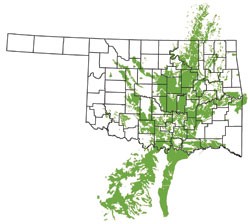
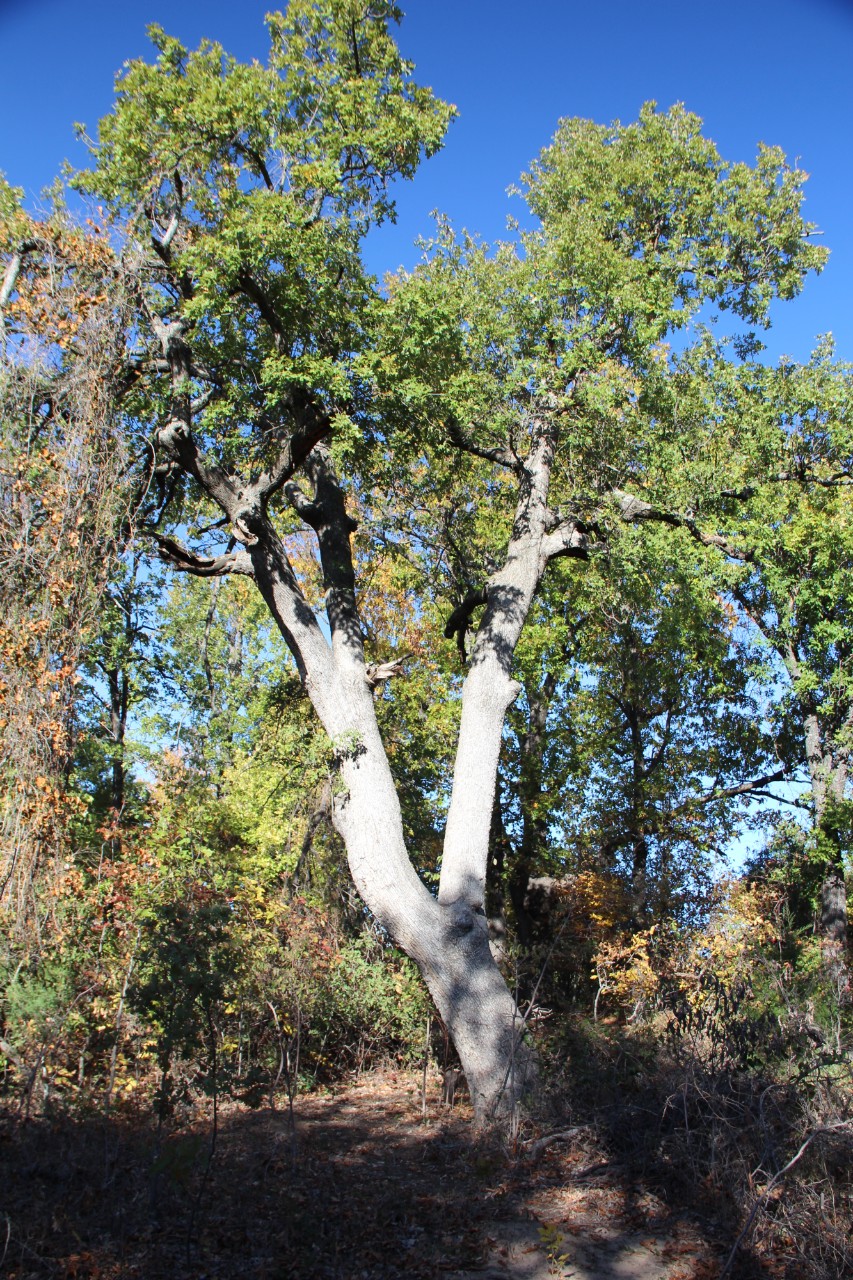
Management
What is Being Done to Help the Cross Timbers?
Oklahoma Forestry Services, Department of Agriculture, Food, and Forestry, and Oklahoma Natural Areas Registry are working with many partners to help educate landowners about the benefits of the Cross Timbers and how to manage this forest type to meet their objectives while conserving and enhancing nature’s benefits.
In central Oklahoma, OFS has worked with Oklahoma State University to study management options of Cross Timbers near Stillwater. OFS also has worked with Oklahoma City and City of Sand Springs to conduct prescribed burns to improve the health of the Cross Timbers surrounding Lake Stanley Draper and the Keystone Ancient Forest. These will be demonstration areas for anyone wanting to learn more about managing Cross Timbers forests. OFS foresters are available to provide technical assistance to any landowners interested in managing their Cross Timbers.
The ONAR encourages citizen-based conservation of Oklahoma’s natural diversity through a voluntary land preservation program. Several Registry sites protect ancient Cross Timbers. If you own land that you believe may have old-growth Cross Timbers, you may contact the Registry Program about becoming a member.
How Can You Help the Cross Timbers?
Think about the values provided by Cross Timbers. Once a forest is removed, it will take more than a lifetime to replace.
Blend Cross Timbers conservation into your land-use plans and strive to retain, maintain, and protect where possible. Learn how to minimize the negative impacts from roads, grading, soil movement, and drainage.
Manage your woodland intentionally to improve and restore forest health and resiliency:
If in doubt, ask a professional for advice. Contact Oklahoma Forestry Services to find a forester in your area.
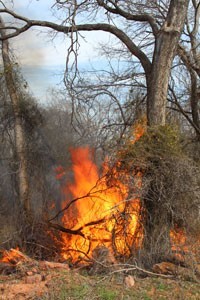
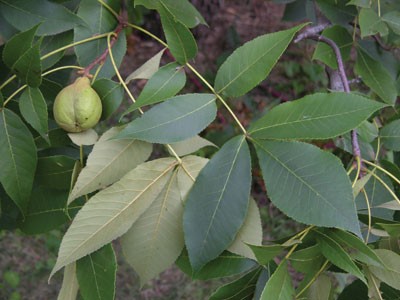
Black Hickory (Carya texana)
Family: Juglandaceae (walnuts, hickories)
Additional common name: Texas hickory
Tree to 10 m (30 ft) tall and 30 cm (12 in) diameter, with irregular spreading crown. Bark blackish or dark gray, becoming thick, rough, and deeply furrowed on older trunks and branches. Twigs slender, brown, rusty-hairy when young. The single terminal bud is small, egg-shaped, with rusty-hairy overlapping scales. Leaves alternate, pinnately compound, 15-30 cm (6-12 in) long, rachis rusty-hairy when young. Leaflets 5 or usually 7, lanceolate, 5-15 cm (2-6 in) long, acuminate, finely serrate, rusty-hairy when young, becoming shiny dark green above, pale green below. Flowers catkins appearing in the early spring. Fruits rounded, 3-4 cm (1.2-1.6 in) long, with a thin husk. Seeds thick-shelled, edible.
Distribution: Native to southeastern U. S., but absent from coastal areas and lowlands.
Habitat: Eastern Cross Timbers and the drier portions of the Oak-Hickory and Oak-Pine forest types.
Comment: The nuts of all the hickories are important food for wildlife, especially squirrels. The seeds of black hickory are thick-shelled but edible. Carya is the ancient Greek name for walnut; texana refers to Texas, where the species was first described.
From the Catalog of the Woody Plants of Oklahoma by Johnson & Hoagland.
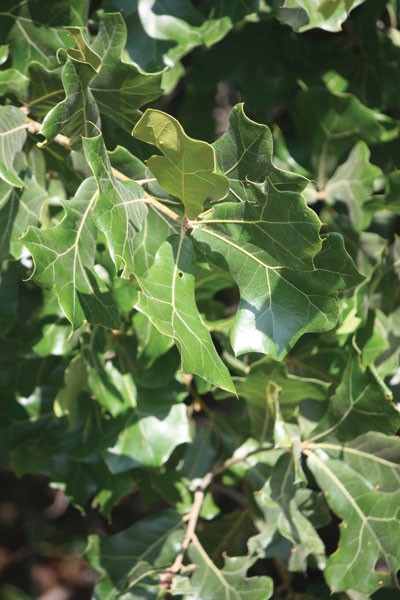
Blackjack Oak (Quercus marilandica)
Family: Fagaceae (oaks and beeches)
Small or medium-sized tree to 18 m (60 ft) tall and 30 cm (12 in) diameter. Bark thick, blackish and divided into rectangular scaly blocks. Leaves 10-25 cm (4-10 in) long, broadly obovate or obovate-oblong, tapering to rounded or cordate broad base, usually shallowly 3-lobed, scurfy-pubescent below and shiny-glabrous above, 10-20 cm (4-8 in) wide across the lateral lobes. Acorn cup turbinate or turbinate-hemispheric, 1.5-2 cm (0.6-0.8 in) diameter. Branches persistent on the tree for many years after they die, resulting in the formation of almost impenetrable thickets in portions of the Cross Timbers.
Distribution: The species is found from the Gulf Coast north to New Jersey, west to southern Illinois and southeast Nebraska.
Habitat: Dry uplands, particularly in sandy or rocky soil.
Comment: Blackjack is a major component of the Cross Timbers vegetation type of Oklahoma, Kansas, and Texas. The wood is hard and heavy but the trees are usually small and gnarled. It is extensively used for firewood in Oklahoma and Texas. Quercus is the ancient classical name for the European oaks; marilandica refers to the state of Maryland.
From the Catalog of the Woody Plants of Oklahoma by Johnson & Hoagland.
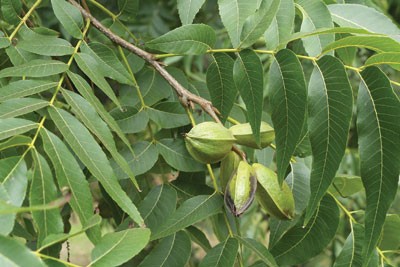
Pecan (Carya illinoinensis)
Family: Juglandaceae (walnuts and hickories)
Description: Tree to 20 m (65 ft) tall and 80 cm (30 in) diameter, with broad rounded crown and widely spreading branches when open-grown. Bark light brown to gray, becoming deeply and irregularly furrowed into scaly ridges on older trunks and branches. Twigs thick, gray-brown, becoming glabrous. The single terminal bud is grayish- or yellowish-hairy, narrow and flattened, with paired scales not overlapping. Leaves alternate, pinnately compound, 30-50 cm (12-20 in) long, with a usually hairy rachis. Leaflets usually 11-17, lanceolate, 5-18 cm (2-7 in) long, acuminate, finely serrate, glabrous yellow-green above, paler below, the lower leaflets usually curved or sickle-shaped. Flowers catkins appearing in the early spring. Fruits oblong, 3-5 cm (1.2-2 in) long, with thin husk splitting along four raised ridges. The seeds are delicious and nutritious, and are eaten by people and numerous species of wildlife.
Distribution: It is difficult to determine the “natural” range of the species, since it was an important food source for Native Americans and was planted as far away as central Mexico in pre-Columbian times.
Habitat: well-drained floodplains (extensively planted in uplands)
NWI status: FAC+
Comment: The nuts of all the hickories are important food for wildlife, especially squirrels. Pecan is an important crop plant across the southern U. S., and is widely planted as a shade tree in towns. Carya is the ancient Greek name for walnut; illinoinensis refers to Illinois, where the species was first described.
From the Catalog of the Woody Plants of Oklahoma by Johnson & Hoagland.
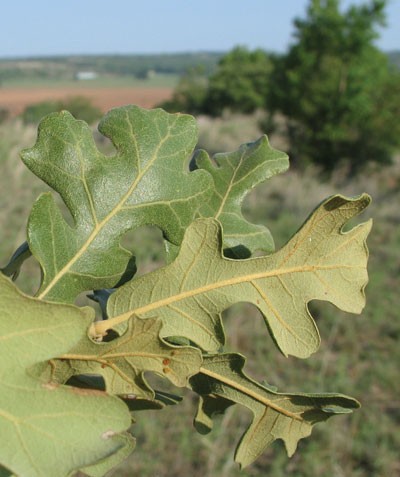
Post Oak (Quercus stellata)
Family: Fagaceae (oaks and beeches)
Small or medium-sized tree to 20m (65 ft) tall and 50 cm (20 in) in diameter. Bark light gray, fissured, scaly. Leaves variable in size and shape, 10-20 cm (4-8 in) long, broadly or narrowly obovate, usually 5-lobed with the upper pair of lobes broad and blunt, glabrous above and brownish-downy below. Stellate hairs are present on the lower surface of leaves and on the young twigs. Acorn cup deeply saucer-shaped and fine-scaled, about 1/3 to 1/2 as high as the ovoid acorn.
Distribution: The species is found from the Gulf Coast north to Massachusetts, west to southern Illinois and eastern Kansas.
Habitat: dry upland to well-drained floodplain.
Comment: Post oak is a major component of the Cross Timbers vegetation type of Oklahoma, Kansas, and Texas. Quercus is the ancient classical name for the European oaks; stellata refers to the dense covering of stellate hairs on the leaves and young twigs.
From the Catalog of the Woody Plants of Oklahoma by Johnson & Hoagland.
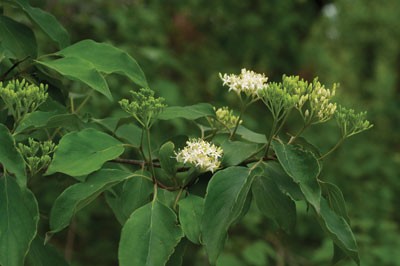
Roughleaf Dogwood (Cornus drummondii)
Family: Cornaceae (dogwood)
Shrub or rarely small tree. Leaves opposite, entire, elliptical, pointed, 4-9 cm (1.6-3.5in) long and 3-5 cm (1.4-2 in) wide with prominent paired curved veins, green and rough above, pale and soft-hairy below. Flowers in flat-topped clusters 5-7.5 cm (2-3 in) across, numerous, small, white, blooming in late spring. Fruits round, about 5 mm (0.2 in) in diameter, white when ripe, in loose clusters at the ends of leafy branches.
Distribution: The species is native to the eastern interior U. S. from Georgia to Pennsylvania west to Texas and Nebraska.
Habitat: most abundant in forest-prairie margins and old fields.
NWI status: FAC
Comment: Cornus is derived from the Latin word for horn, referring to the hard wood; drummondii is in honor of Thomas Drummond, a Scottish explorer who collected plants in Texas.
From the Catalog of the Woody Plants of Oklahoma by Johnson & Hoagland.
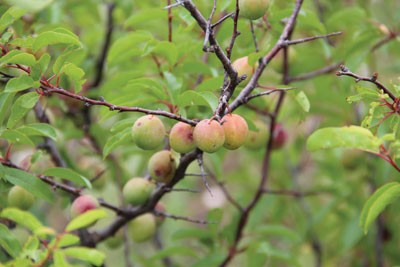
Chickasaw Plum (Prunus angustifolia)
Family: Rosaceae
Additional common name: sand plum
Shrub to 3 m (9 ft) tall, forming dense clonal thickets. Crown irregular. Bark red-brown to dark gray with thin scales; prominent lenticels. Twigs lustrous red-brown, pubescent. Leaves alternate, simple; lanceolate or oblong-lanceolate, 2.5-5 cm (1-2 in) long and 8-16 mm (0.3-0.6 in) wide, glabrous or slightly pubescent beneath; lustrous green above, paler beneath; rounded and broadly cuneate at base, acuminate to acute at apex; margins sharply serrate with glandular teeth; petioles 6-12 mm (0.25-0.5 in) long, slender, glabrous to pubescent, may have 2 red glands near the apex. Flowers in umbels, glabrous with 2-4 flowers about 8 mm (0.3 in) in diameter; calyx-tube campanulate, glabrous, 5 lobes; petals 5, white; styles 1; stamens 15-20; flowers appear from March to April. Fruits drupes, 12-18 mm (0.5-0.75 in) in diameter, globose, red; fruits mature May to July.
Distribution: Oklahoma and Texas , north to New Jersey, south to Florida and west to Louisiana. Common.
Habitat: sandy soil. Fencerows and thickets.
Comments: Prunus is the classical name for European plums; angustifolia refers to the narrow leaves.
Horticulture: Easily grown from seed or transplant.
Food uses: The fruits can be eaten raw or cooked. They are often prepared as jelly or preserves. Native Americans sun dried the plums for winter consumption, but not all tribes removed the pits first.
Wildlife benefits: The fruits of Chickasaw plum are eaten by several species of birds and mammals. The dense thickets also provide cover.
From the Catalog of the Woody Plants of Oklahoma by Johnson & Hoagland.

Indian Woodoats (Chasmanthium latifolium)
Family: Poaceae
Additional common name: Fish-on-a-pole grass, Inland sea oats, Wild oats, River oats, Flathead oats, Upland Oats, Upland Sea Oats
This is a 2-4 ft., clump-forming, perennial grass bearing large, drooping, oat-like flower spikelets from slender, arching branches. The blue-green, bamboo-like leaves often turn a bright yellow-gold, especially in sunnier sites, in fall.
From the Lady Bird Johnson Wildflower Center Native Plant Database.
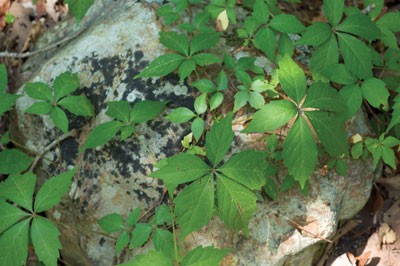
Virginia Creeper (Parthenocissus quinquefolia)
Family: Vitaceae (grape)
Woody vine, high-climbing by branched tendrils tipped with adhesive disks. Leaves long-petioled, palmately compound. Leaflets usually 5 (3-7), elliptic to obovate, to 15 cm (6 in) long and 8 cm (3 in) wide, acuminate, coarsely serrate above the middle of the blade, glabrous and dull green above, paler and sometimes pubescent below. Inflorescence a panicle of cymes. Flowers small, numerous, yellowish-green, blooming in late Spring or early Summer. Fruits black or dark blue drupes, globose, 5-9 mm (0.2-0.4 in) in diameter, with 1-3 seeds, ripening in Fall.
Distribution: Native to the eastern half of the U. S., southeastern Canada, and northeastern Mexico.
Habitat: Bottomland forests, oak-hickory forests, Cross Timbers.
NWI status: FAC
Comment: Virginia creeper is one of the most common plants in the forests of Oklahoma. It is also widely planted as an ornamental, since it is able to climb brick and stone walls. Parthenocissus is from a Greek phrase meaning “virgin ivy”; quinquefolia refers to the five leaflets.
From the Catalog of the Woody Plants of Oklahoma by Johnson & Hoagland.
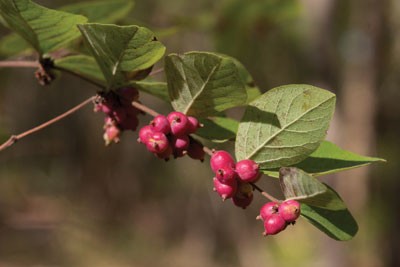
Buckbrush (Symphoricarpos orbiculatus)
Family: Caprifoliaceae
Additional common name: coralberry
Shrub to 1 m (3 ft) tall. Leaves opposite, elliptic to suborbicular, 2-6 cm (0.8-2.4 in) long and 1-3.5 cm (0.4-2.4 in) wide, base cuneate to rounded, acute to obtuse at apex, usually entire. Flowers in spicate axillary clusters of several small greenish flowers. Fruits in axillary clusters of small pink to purple drupes. The species is rhizomatous and forms large colonies in forested areas.
Distribution: Native to eastern United States westward to Nebraska and Texas.
Habitat: upland and bottomland forests, sometimes in prairies.
NWI status: FACU
Comment: Coralberry is one of the most common plants in the forests of Oklahoma. Symphoricarpos is derived from a Greek phrase referring to the clusters of fruits; orbiculatus refers to the round leaves.
From the Catalog of the Woody Plants of Oklahoma by Johnson & Hoagland.
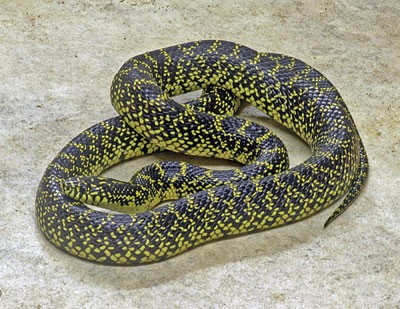
Speckled Kingsnake
Lampropeltis holbrooki
Family: Colubridae
The Speckled Kingsnake is a moderately large snake with smooth scales, and a background color of black. Each scale has an irregular yellow marking that varies in size and shape giving the snake an overall speckled appearance. Speckled Kingsnakes vary in size from about eight inches as hatchlings to at least 72 inches as large adults. Typical adult size is 36 to 48 inches.
Speckled Kingsnakes are active from early Spring through late Fall. In Spring and Fall, these snakes are primarily active during the day but as temperatures increase in summer, they are active at dusk and at night. They occur in nearly all habitats, from riparian forests to open prairie.
Although Speckled Kingsnakes are often referred to as “cannibalistic,” they typically do not eat other Speckled Kingsnakes. These snakes are best known for their ability to eat large snakes, including venomous species such as Western Massasaugas and Prairie Rattlesnakes. A Speckled Kingsnake can eat snakes as long or longer than they are. Speckled Kingsnakes are harmless to people.
From the Reptiles and Amphibians of Oklahoma’s WMAs by Laurie Vitt.
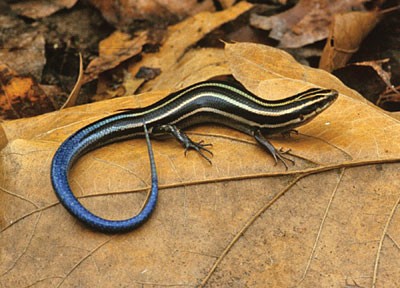
Five-lined Skink
Plestiodon fasciatus
Family: Scincidae
Five-lined Skinks are small to medium-sized lizards with smooth, glass-like scales, well-developed limbs, and a tail that is slightly longer than the body. They closely resemble the larger Broad-headed Skinks in coloration and overall morphology. Juveniles are black with five distinct white stripes extending from the head to the first one-third of the tail. The stripes become less well defined as the skinks age, with the background coloration fading to brown or tan.
Five-lined Skinks are strictly diurnal and are usually associated with hardwood forests. Juveniles can be active on sunny days as early as March, but most activity of adults and juveniles occurs from April through November, depending on local climatic conditions. Mating occurs from May through June. During the mating season, heads of males turn bright red or orange as a result of hormonal changes associated with breeding.
Five-lined Skinks feed primarily on small insects and spiders. Similar to other skinks, Five-lined Skinks use chemical cues to determine sex and reproductive status during social interactions and to discriminate prey. They avoid insects that produce chemicals for defense, such as many ants and beetles. The brightly colored tails of juveniles are easily lost. Juveniles often flick the tail around when they bury their heads in leaf litter searching for prey. This behavior appears to distract birds and other potential predators away from the skink’s body and to the tail. Juveniles can regenerate their tails in about five weeks. When Five-lined Skinks reach sexual maturity, the tails lose their brilliant blue coloration and they are not as easily lost.
From the Reptiles and Amphibians of Oklahoma’s WMAs by Laurie Vitt.
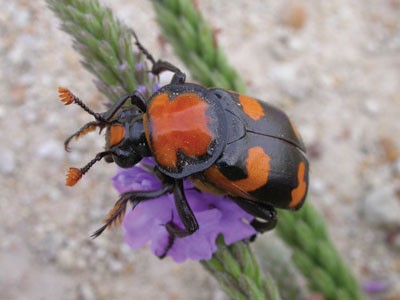
American Burying Beetle
Nicrophorus americanus
This large beetle is approximately 1-1.5 inches long. As the largest member of the carrion beetle family, it feeds on the carcasses of dead mammals, birds and reptiles.
The American Burying Beetle occupies a wide range of habitat types including tallgrass prairie, woodlands, and forests. They reproduce in the spring and summer (early May through August). A pair of beetles will find a carcass that is approximately the size of a rat, bury it a few inches below the surface of the ground and lay a small clutch of 10 to 25 eggs on it. Their populations appear to be more limited by the availability of suitable carcasses for reproduction than by habitat loss.
Currently, the American Burying Beetle occurs across the eastern third of Oklahoma. Despite its apparently wide range, it is rare in most of the places where it occurs. In addition to Oklahoma, populations exist in Arkansas, Missouri, Kansas, Nebraska, South Dakota, Rhode Island and Massachusetts. Historically, the American Burying Beetle occurred through the eastern United States from the eastern edge of the Great Plains to the Atlantic Coast. The reasons for the decline in American Burying Beetles are uncertain. Pesticide use has been speculated as a leading cause. Another potential factor may be a reduction in the abundance of carcasses that are of suitable size for success reproduction.
From the Oklahoma Department of Wildlife Conservation Rare Species Page
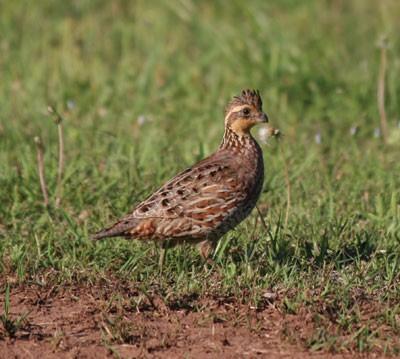
Northern Bobwhite
Colinus virginianus
Order: Galliformes (grouse, quail, and allies)
Family: Odontophoridae (new world quail)
Bobwhite are small quail with rounded bodies, small heads, rounded wings, and short tails. They are intricately patterned in brown, rufous, buff, and black. Males have a bold black-and-white head pattern. Females have a buffy throat and eyebrow. Northern Bobwhites travel in coveys and run across the ground from the shelter of one shrubby patch to another. When they are flushed, they explode into flight with quick wingbeats and then duck into the nearest cover. Northern Bobwhites live in open pine forests, overgrown fields, shrubby areas, and grasslands. They respond well to areas managed with prescribed fire, which helps to maintain an open, grassy ground layer.
Because of its history as a game bird, the Northern Bobwhite is one of the most intensively studied bird species in the world. Scientists have researched the impacts of various human activities, from pesticide application to prescribed burning, on both wild and captive bobwhites.
Despite their sharp population decline, it’s still possible to find Northern Bobwhite in fields, rangelands, and open forests over much of their range. Their call is one of the easiest to learn of all bird sounds. The two sharp, whistled notes really do sound like “bob-white!”—and the call carries a long distance, so if bobwhite are around you will probably know it long before you see them. Look for these unobtrusive birds pecking and scratching on the ground near to or underneath vegetation—or, more likely, bursting upward into a short flight of flurrying wings if you get too close.
From the Cornell Lab of Ornithology All About Birds.
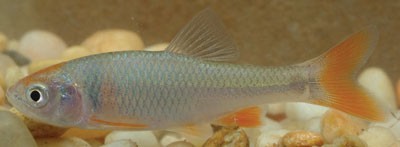
Red Shiner
Cyprinella lutrensis
Family: Cyprinidae (minnows)
Order: Cypriniformes (carps, minnows and loaches)
Other Common Name: Red-horse Minnow
Cyprinella is Greek for “small carp” and lutrensis is derived from the Latin lutra which means “otter”, a reference to Otter Creek, Arkansas, where the species was first captured. Coloration is similar to the blacktail shiner, olive green above and silver on the sides. Spawning males become bluish on the sides and the fins redden. Maximum size is only about 3.5 inches.
The red shiner spawns over an extended period of time from spring into fall months, with a peak from early to mid-summer. Spawning may occur on riffles, on or near submerged objects, over vegetation beds, or in association with sunfish nests. Adults typically school in midwater or near the surface. The species is thought to feed primarily on small invertebrates.
The red shiner is native to central North America west of the Mississippi River drainage, ranging as far west as New Mexico. Latitudinally, the species ranges from central Mexico north to South Dakota. Clearly a plains species, red shiners range throughout Oklahoma.
From the Texas Parks & Wildlife Wildlife Fact Sheets.
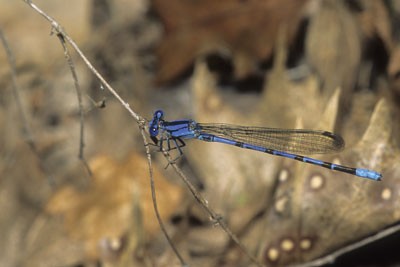
Springwater Dancer
Argia plana
Family: Coenagrionidae (narrowwinged damselflies)
Suborder: Zygoptera (damselflies)
Order: Odonata (dragon and damselflies)
Male springwater dancers typically perch on vegetation at short or in water. They can be found along small to medium shallow streams, rocky and sandy, in or out of woodlands. They may use quite small springs or highside trickles, often at tiny seeps with no other species of dancers. This species is considered indicative of springs in some parts of its range. The males are not territorial, but may be spaced about 3 feet apart along streams because of aggressive behaviour toward intruders.
From Dragonflies and Damselflies of the West by Dennis Paulson
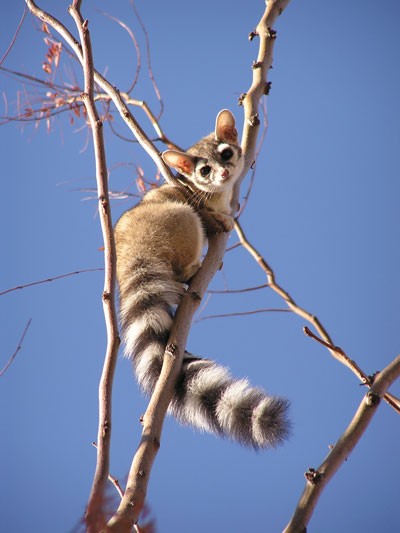
Ringtail
Bassariscus astutus
The Ringtail is a cat-sized carnivore resembling a small fox with a long raccoon-like tail. Its bushy tail is flattened and nearly as long as the head and body, with alternating black and white rings. These animals are almost wholly nocturnal and spend the majority of the day sleeping in their dens. They leave their dens at night to feed. Ringtails eat a wide variety of foods. Birds, rodents, carrion, reptiles and amphibians, and insects such as grasshoppers and crickets form the bulk of their diet, although they also eat native fruits and berries as well. The breeding season of the Ringtail is in mid-spring. Most litters consist of two to four babies, which are born covered with short, pale hair, unable to see and hear. By the age of four months, young Ringtails have acquired their adult coloring.
Ringtails live in many different habitats, but they prefer rocky areas such as rock piles, stone fences, canyon walls, and talus slopes. Ringtails are expert climbers, capable of climbing vertical walls to find the most protected crevices, crannies, and hollows in which to build their dens. In woodland areas, where they are less common, they den in hollow trees and logs. They have also been observed living in buildings and neighboring open edges and fields.
From the Texas Parks & Wildlife Wildlife Fact Sheets
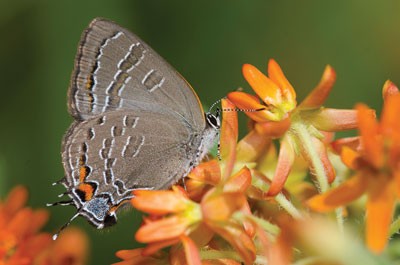
Banded Hairstreak
Satyrium calanus
Subfamily: Lycaenidae (coppers)
Superfamily: Papilionoidea (true butterflies)
Identification: Hindwing has 1 long and 1 short tail. Upperside of both sexes dark brown. Underside of hindwing dark brown with postmedian band of dark dashes edged in white. Blue tail-spot not topped with orange.
Wing Span: 1 – 1 1/2 inches (2.5 – 3.8 cm).
Life History: Males perch on low shrubs and tree branches during the day, watching for females. Eggs are laid on twigs of the host during the summer, and hatch the following spring. Caterpillars eat catkins and leaves.
Flight: One flight from June-August in the north, April-May in Florida.
Caterpillar Hosts: Many species of oak (Quercus), walnut (Juglans), and hickory (Carya).
Adult Food: Nectar from flowers including dogbane and common milkweed (preferred), chinquapin, small-flowered dogwood, New Jersey tea, meadowsweet, staghorn sumac, white sweet clover, and yarrow.
Habitat: Forest areas and neighboring open edges and fields.
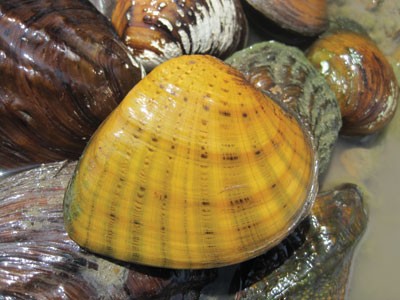
Butterfly Mussel
Bassariscus astutus
Phylum: Mollusca
Family: Unionidae (freshwater mussels)
The Butterfly mussel is a small to medium-sized freshwater mussel that is sexually dimorphic. Female specimens tend to be more inflated or swollen in appearance and generally measure less than 2.75 inches (70 mm) in length. Male Butterfly mussels are more compressed and larger, usually measuring less than 4.3 inches (110 mm) in length. The unique shell is triangular in shape. The periostracum (outer shell surface) is dull yellow or greenish and may be marked with broken green rays. These broken rays look like rows of “V”-shaped or rectangular blotches. The nacre (inner surface of the shell) is white.
Some of the specific details about the complex life cycle of this mussel are not currently known, but the life history of Ellipsaria lineolata is presumed to be similar to related species. Male Butterfly mussels release sperm into the swift current of a river. Sperm enters females through siphon-like regions and fertilization of eggs occurs within female shells. These fertilized eggs develop into special larva called glochidia. Glochidia continue to develop and are released into the water column when fully matured. The parasitic glochidia must find and attach to the gills or fins of the appropriate host fish to complete development. The Green Sunfish (Lepomis cyanellus)and Freshwater Drum (Aplodinotus grunniens) have been identified as suitable host fish. Larvae transform into juvenile mussels on the fish and then release from the host to find a suitable substrate, often the gravel or sand bottom of a river.
Adult mussels are typically found attached to the sand or gravel bottom of swiftly flowing rivers. Adult mussels are filter feeders and usually feed upon plankton and detritus from their aquatic environment. Butterfly mussels bring water from their habitat into their shells through specialized regions that are similar to the true siphons of clams. The water is then filtered over its gills and food particles are trapped and eventually digested.
The Butterfly mussel has a very broad range that covers the Alabama River system in the Southeast and Mississippi River drainages throughout the Midwest .
From the University of Georgia Museum of Natural History Georgia Wildlife Web.
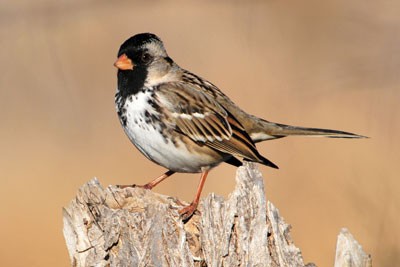
Harris’s Sparrow
Zonotrichia querula
Order: Passeriformes (perching birds)
Family: Emberizidae (new world sparrows)
Because of its remote and restricted breeding grounds, the Harris’s Sparrow was one of the last North American species to have its nest discovered. The first nest was found in 1931 at Churchill, Manitoba, by soon-to-be Cornellian George M. Sutton. The Harris’s Sparrow is the only bird species that breeds in Canada and nowhere else in the world. In winter flocks, Harris’s Sparrows maintain linear dominance hierarchies that determine access to food and roost sites. The most dominant birds are the oldest males, and they also have the largest bibs. If first winter birds have their feathers dyed black, creating an artificially large bib, they rise in the dominance hierarchy. Harris’s sparrows are omnivorous, eating seeds, fruits, insects, and young evergreen needles. The birds feed primarily from the ground, picking through leaves and scratching. They will feed from bird seed scattered on the ground.
From the Cornell Lab of Ornithology All About Birds.
Photographers
All photographers generously donated their work for this project